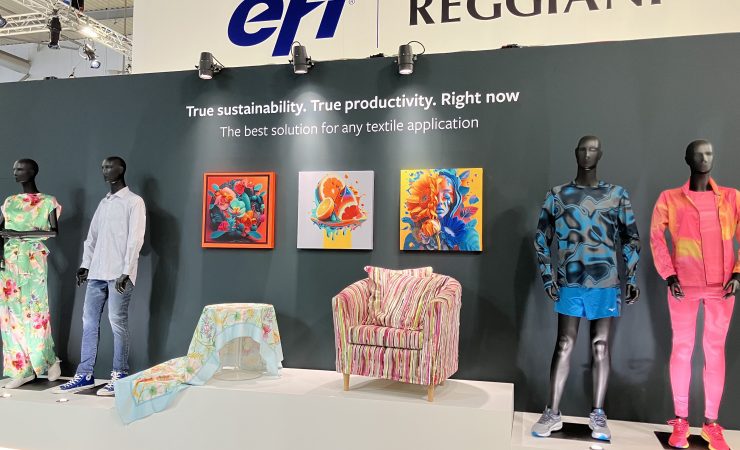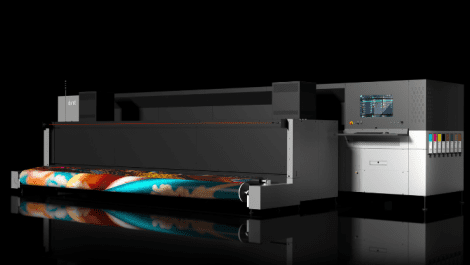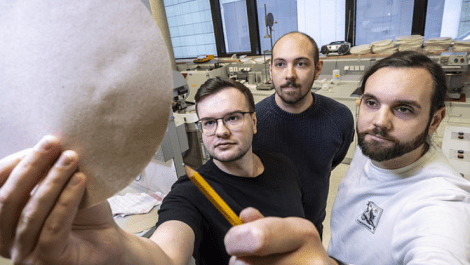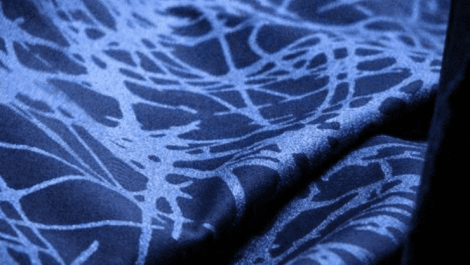As part of using ITMA to ‘reinvent’ its textiles printing offering to a purely digital one, EFI Reggiani premiered its fastest-yet single-pass Bolt printer, introduced Query analytics software and presented various updates to the EcoTerra range of pigment printers, inks and Hyper scanning printer.
The new Bolt XS is a thorough redesign of the original Bolt model that appeared in 2021, capable of printing at up to 100m/min, and described as a replacement for rotary analogue screen printers. It features recirculating printheads and contactless wiping to optimise uptime, and according to senior manager product marketing Micol Gamba, offers a total cost of ownership approaching that of rotary printing for short and medium runs. The new design occupies some 30% less floor space than the previous one, and uses roll-feeding technology derived from Reggiani’s analogue past. It is driven by a Fiery front-end, which provides uniformity correction and compensation for blocked nozzles.
Both production detail and top-level dashboard information are provided by the Query software, allowing production to be analysed by shift, design or any other parameter, including usage of the printable media width. It also monitors the sustainability footprint of the shift or job, enabling its users to provide a level of certainty and detail that is increasingly being requested by brands as part of their own sustainability efforts.
ITMA also saw the appearance of the Inèdit textile software range under the EFI banner for the first time since its acquisition in June 2022. This comprises the NeoStampa Rip, NeoTextil plug-in for Adobe Photoshop and Neo Catalog online catalogue software. Although the Rip will drive other manufacturers’ printers, users of Reggiani machines benefit from encrypted connection , further protecting designs in production. The software can also generate colourways and photo-realistic previews or simulations of printed textiles, while managing colour for accuracy and enabling reference colours to be sampled from any real-world source.
The company also updated on its EcoTerra pigment-based printer line which requires no external pre- or post-processing, saving up to 95% on water, 75% chemistry and 60% on energy. There are now four models in the range, and six variants, covering print widths up to 3.4m, to suit a wide range of applications, from fashion to decor. The Hyper printer is said by EFI to be the fastest scanning model available, able to print on two rolls simultaneously for an effective 20m/min speed and now offering improved quality and nozzle failure compensation in two-pass mode. Reggiani’s ink range now encompasses dye sublimation, pigment with or without binder, reactive, dye disperse, acid and the EcoTerra pigment type.
Speaking at the press launch, chief technology officer Doug Edwards commented that digital penetration of the textile print marketer was currently around 8–9% based on value, but that it was approaching tipping point, as had been seen in the ceramics sector. CEO Scott Schinlever added that the biggest barrier to uptake was not the technology but potential users’ ability to grasp the total cost of ownership argument rather than fixating on ink prices. He also noted that the strong sustainability arguments for digital print would be helped by the imposition of increasingly stringent regulations on the industry.





